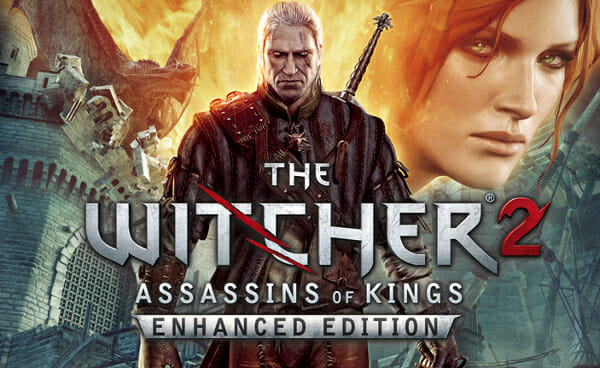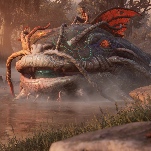The Witcher 2: Assassins of Kings Enhanced Edition (360/PC)

In videogames, players are, by design, prime donne. Even more than in static art, games pamper the consumer’s id, reminding him (for example) that his battle prowess saved the immobile townsfolk from the sedentary sea beast, that his infinite wisdom preempted the poisonous bog with anti-poison, and that his masterful stroke (pressing A) set into sequence the artificial justice of the “good ending”. How unfathomable, the game declares, is his well-timed save tactic! How divine his perusal of the Achievements!
You might guess that my false enthusiasm is leading to the commendation of a game that does the opposite, which would only be half true. The Witcher 2: Assassins of Kings Enhanced Edition (which I’ll abbreviate as T2: Assassins Day for the parallel plot structures and time warps) makes no royal bones about dethroning players and casting them into the dirty, bigoted streets of fantasy realism. If The Elder Scrolls is The Lord of the Rings, for a cross-media example, then T2: Assassins Day is Game of Thrones. (For those keeping count, Sean Bean is in three of those and not in the one that rhymes with The Hitcher, which Sean Bean is also in.)
An action-RPG equally weighted by the implications of both genres, The Witcher 2 (an abbreviation for T2: Assassins Day) is balanced in every sense, for better or worse, propped up by the fascinating lore of the Polish fantasy series The Witcher by Andrzej Sapkowski. While brusque dialogue choices can determine an alternate course for over a staggering third of the experience, the world within is as immovable as is its source material. Its fiction is labyrinthine, its map consuming, and its vision clear.
So clear, in fact, that its strong authorship will likely alienate RPG fans in the way that Metro 2033 put off shooter fans. Its world and narrative are rich and compelling, but don’t always star the player like, for example, The Elder Scrolls V: Skyrim, an open-world avatar ant farm lovingly dedicated to the ant’s free will. Within The Witcher 2’s disciplined framework, players choose which of the protracted side missions to undertake, how to prepare for and engage in skill-based combat, and which of the more menial activities to participate in, like gambling, drinking, or picking poultice herbs (which is in no way a subtle reference to the game’s interactive houses of debauchery). Events within Temeria or Aedirn may shift political lines, but this world, like ours, has too much past for a player’s whim to make sweeping paradigm shifts.
As players assume the identity of Geralt of Rivia – a human mutant, intruder, scapegoat, and savior – they’ll begin to see the game as the game might see them. Geralt will spend most of his time out of combat, where he’ll manage quests, explore, or meditate, which is a lucid example of how the RPG elements of preparation play off of the action elements in the combat system.

Meditation allows Geralt to sit cross-legged and consider his strategic approach to hostile encounters. Some require greater agility, which he can alter in his skill tree. Some require stealth, which can be enhanced by drinking the Cat Potion for x-ray vision (obviously). Others still require a particular sword oil or trap, perhaps anti-venom, that Geralt can fashion from gatherable components. This detail-oriented preparation slows the game down considerably, but it’s vital to surviving the “reverse difficulty curve” of pack enemies, even if most boosts are temporary. Prepare to prepare.
If contemplation isn’t in the cards, but for some reason you’ve bought and committed to this action-RPG, humans and monsters can always be slain with the right combination of skill and luck in battle. While running away to heal is my preferred tactic, the slick swordplay – made slicker by console controls in the new Xbox 360 Enhanced Edition – offers the opportunity to parry blows precisely and counter effectively. Weapon combat tends to follow the block-strike-block formula, but introducing Signs, or magic symbols innate to the witcher race, and a time-slowing mid-combat menu to switch signs, weapons, and items, enables Geralt to improvise with support abilities ranging from a force push to mind control to minor healing to elemental traps. The more hits Geralt lands, the more signs he can use in concert with his primary sword, silver sword, or bombs to fell groups of guards or man-sized insects, among other enemies. Mothra-sized “boss” monsters are felled, normally, by the virtue of patience.
-

-

-

-

-

-

-

-

-

-

-

-

-

-

-

-

-

-

-

-

-

-

-

-

-

-

-

-

-

-

-

-

-

-

-

-

-

-

-

-








































